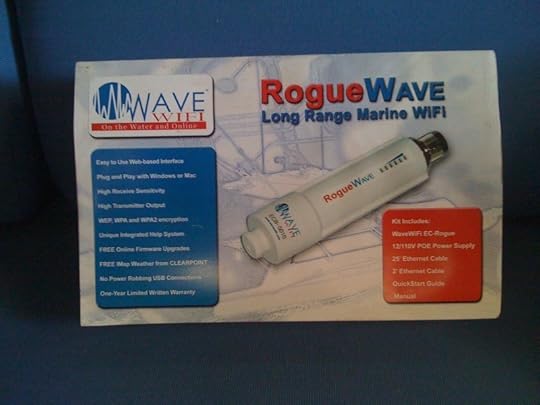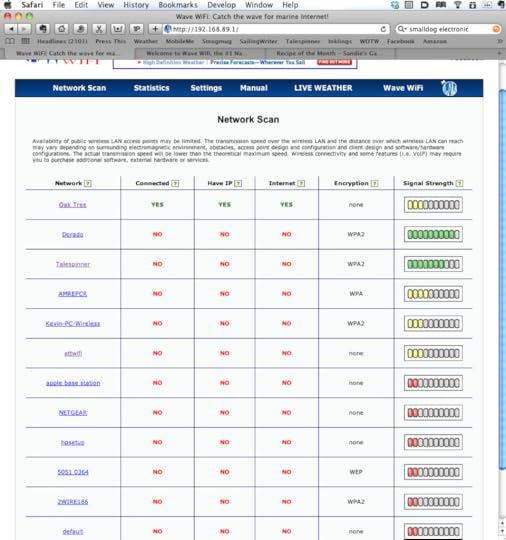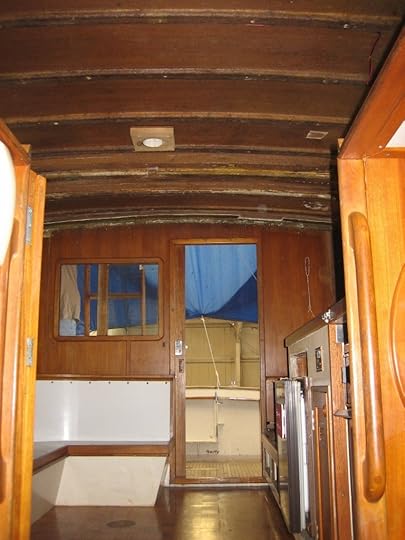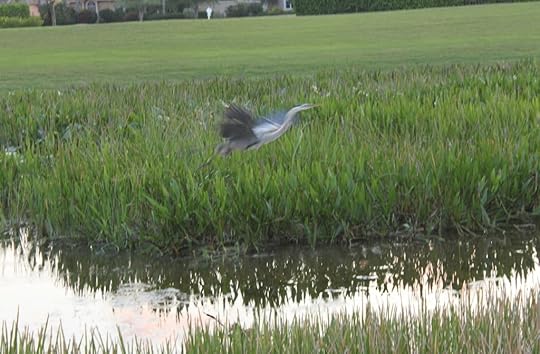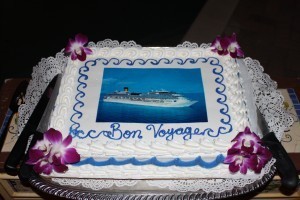Mike Jastrzebski's Blog, page 91
May 8, 2011
Lin and Larry Pardey
By Mike Jastrzebski
This Friday Christine Kling will be posting an interview with Lin Pardey, whose new book has just been released. It's available here in hardcover, Bull Canyon: A Boatbuilder, a Writer and Other Wildlife, and here as a Kindle ebook, Bull Canyon: A Boatbuilder, a Writer and Other Wildlife .
.
Why are we excited about this? Well, the subtitle of this blog is so you want to quit your job, move onto a boat, and write. The Pardeys have been doing just that for a lot of years.
Fifteen years ago when we bought Rough Draft and started planning to quit our jobs and move onto a boat, some of the first articles and books I read were by the Pardeys, such as Cruising in Seraffyn and The Cost Conscious Cruiser .
.
So if you get a chance check out Lin's new book and her interview with Christine Kling this Friday–and please, share the news on Facebook and Twitter so that others who share the dream of getting away from it all and writing can read what Lin Pardey has to say about her experiences.
Share on Facebook
May 6, 2011
I've Found my Wifi
Back in September, I posted a blog called I Want My Wifi all about my search for the best solution for connecting to wifi stations while cruising. I can attest to the need for such a device after the many hours I've spent at anchor trying to balance my laptop on the dodger or hatch cover while trying to connect using my laptop's own wireless card. It just doesn't have the strength. So, what I was looking for was an external antenna and bridge to bring the signal to my laptop.
In the earlier blog, I examined the various pros and cons of the different devices, and I concluded that I wanted something that would have at least a 25-foot cable (with no signal loss) and would connect via browser-based firmware. That pretty much ruled out the USB products, and it put me in the market for something that used the Ubiquiti Bullet, the great single unit bridge that has become the base for most of the units that use ethernet cable to connect to the antenna.
I also decided I would not go the DIY route on something so critical to my work and happiness. I wanted to find excellent tech support. Several friends had told me that the AirOS firmware that shipped with the Bullet was not designed for non-professionals like me, and I took their word for it.
At the Dania Beach Marine Flea Market, I met Randy Nial from Land and Sea Wifi. He was there with a Boat Show Special on the Rogue Wave. When I heard that it used their own proprietary firmware with a super easy-to-use interface for connecting to hotspots, I was sold. As a Mac user, I am tired of being left in the cold when companies decide to stop supporting the Mac with their latest version of the firmware. And I know how frustrating it can be when new networks present new problems, and I don't understand all the various settings.
Randy gave me a great deal, but I would never recommend something if I didn't think it was a terrific product. I was prepared to turn right around and return it if the product was not up to par. The fact is, I couldn't be happier. I know Randy's not a Mac guy so he might not get this, but the highest compliment I can give to a tech product is that it is very Mac-like. And so it is with the Rogue Wave. Clean, simple, and it just works.
I also got one of their NetGear 12V wireless routers so that I will be able to use my iPad and iPhone on the boat's wifi network. Both the Rogue Wave and the router can be ordered with 12V cigarette lighter plugs – which I got – and now I have no use anymore for my small inverter. I am currently hooked up to the Rogue Wave and connected to my own AT&T U-verse network. Downloading a Netflix movie, I can't tell any speed difference by connecting through the antenna.
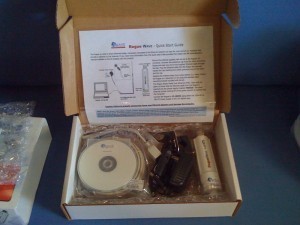 The set up of my new antenna and router could not have been simpler. Plug and play really is an exact description of how it works. Following the clear printed instructions, I screwed the 8.5 dB omnidirectional antenna to the top of the bullet-shaped bridge. On the bottom, there is a great split rubber plug that fits around the ethernet cable to keep it all weatherproof.
The set up of my new antenna and router could not have been simpler. Plug and play really is an exact description of how it works. Following the clear printed instructions, I screwed the 8.5 dB omnidirectional antenna to the top of the bullet-shaped bridge. On the bottom, there is a great split rubber plug that fits around the ethernet cable to keep it all weatherproof.
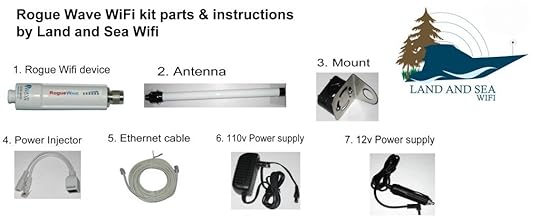 Finally, at the other end of the cable, I attached the PoE or 'Power Over Ethernet' cable by attaching one leg to my computer and the other to the power cord. I typed in the IP address of the device (as explained), and presto, there was the lovely user interface with WAAAY more stations visible than before – including the Starbucks up the street. I selected an unknown unlocked station, clicked on 'connect' to select, and presto–
Finally, at the other end of the cable, I attached the PoE or 'Power Over Ethernet' cable by attaching one leg to my computer and the other to the power cord. I typed in the IP address of the device (as explained), and presto, there was the lovely user interface with WAAAY more stations visible than before – including the Starbucks up the street. I selected an unknown unlocked station, clicked on 'connect' to select, and presto–
I found my wifi.
What more could I ask?
Fair winds!
Christine
Share on Facebook
May 5, 2011
Itching to get started…
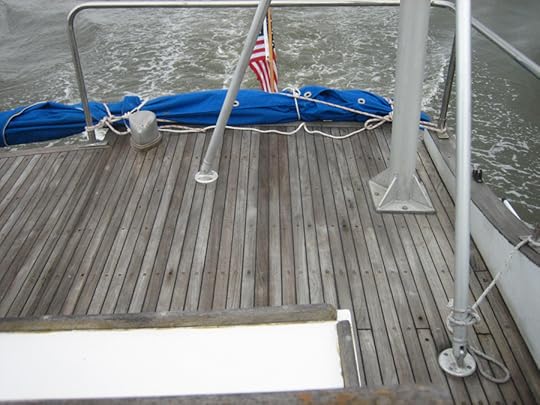
The general idea of a boat is simple. It's designed, in theory, to keep water on the outside. In theory, at least. But the reality is that boats leak. I often describe Annabel Lee as a collection of leaks in the shape of a boat. But we're preparing to eliminate the largest source of leaks: the bridge deck. Here's some background:
Aboard our trawler, the bridge deck consisted of what once had been ½" teak decking fastened down over fiberglass. The previous owner, I'm told, was very fond of two things: bright, honey-colored teak decks… and his belt sander. The sad result is that he sanded the decks clear down to their fasteners, which led to years of water gradually seeping through to the coring. Fortunately the coring in question was yet more solid ½" teak lumber so there is no rot involved, but unfortunately years of that saturated teak freezing and thawing had compressed the wood fibers and led to it delaminating from the fiberglass both above and below, undermining the deck's strength.
The damaged area spans roughly 8' by 8', and while we could repair individual sections, we decided it would be best to remove all damaged core and delaminated glass, rebuild the salon coach roof and stringers, and reglass it above and below. We constructed a frame to duplicate the precise camber of the area, and have clamped down three layers of marine-grade ¼" ply with alternating seams to preshape the wood. Our intention is to laminate these layers with epoxy, as well as laminate stringers to the duplicate dimensions of the originals. The cabin will be braced from all sides, the damaged area of the deck removed and the new laminate positioned and epoxied in place. From there it would be glassed above and below to match the original thickness, using 17 and 18 oz. Biaxial glass/mat and 1.5 mat and Vinylester resin, faired to join the un-damaged remainder of the deck.

This deck job has been delayed by work and health, but at this point it will be going forward. Before we began I figured I'd tap the collective wisdom of this group and see what input any of you have to offer. No, we've never done work like this before, and yes, we're approaching it with a large amount of trepidation. But we've been through something similar when we repaired some pre-existing damage to the keel; we approached that project with caution and as much research as we could gather, and discovered in the end it was simply a matter of having the cojones to attach the hull with power tools, and then many small steps to put it back together, stronger and better than when we began. And through the keel project I lost all fear of working with fiberglass. It's sticky, messy, itchy work, but in a strange way it's kind of fun. But I figured I'd share with you all my next level of insanity. Any advice, suggestions or just plain sympathy would be greatly appreciated!
Share on Facebook
May 3, 2011
Are you a writer and a boater with something to say?
By Mike Jastrzebski
At Write on the Water we typically have 3 or 4 guest posts a month. Today was one of the slots that I keep open for guests, but our normal list of guests didn't fill the slot so I have a proposal for our readers.
I'd like to offer one of our readers a chance to write a guest post for Write on the Water to appear on Wednesday, June 15th.
Here's what I'm looking for:
The post should be about writing or boating, or writing and boating and run between 500 and 800 words.
If you are interested here's what you have to do.
1) Comment on this post and include a little background about your boating and writing experience.
2) Send me an idea of what you want to write about no later than Wednesday, May 18th to mike at mikejastrzebski.com.
I will then pick a reader to guest blog on June 15th.
Please be aware that none of our bloggers are paid. This is an opportunity to get a little exposure and let others know what's on your mind.
Share on Facebook
May 2, 2011
Don't Pull on That Thread!!! Unless You Have To
by Tom Tripp
Oy. I did it. I pulled on the thread that you're not supposed to pull. It seems there's a good reason not to pull on the thread. Now I have to fix it. I'll come back to this in a minute.

Um, yeah, I pulled on the purple thread. Photo - Christopher J. Flynn, Wikimedia Commons
I've had a lot of "real" work lately, so the novel has been sitting quietly in the back of my head while I was distracted with stuff that brings income in NOW. But as we all know, it never sits there truly quietly. It wiggles around, moves up and down and generally vies for attention. If you're like me, it usually gets that attention, at least from my subconscious if not the conscious part of my brain.
Something about the storytelling in this novel has been bothering me but I wasn't able to put my finger on it. The other day, while talking to a friend about her novel, I realized that my problem was with the building of suspense in my own story. I had revealed too much about the antagonist(s) early on and in doing so had robbed myself (and my future potential readers) of a chance to learn more slowly and deliberately, about who they were and what their motivation was.
So when I finally got a chance to sit down at my laptop I pulled on that particular thread in the literary tapestry I've been weaving. What a mess. It ain't so much a tapestry anymore. Now I've got to stretch the damned thing out again and re-weave this thread more cleverly and with more subtlety.
I guess there are as many plot models as there are thriller/mystery writers, and I don't think it's necessarily bad to write a story the way I had originally, but in this case it robbed the overall effort of some naturally building tension and I needed to fix it. I wanted to have the plot tension build as deliberately as the tension in my character development. It seems a more natural fit in this story.
I'm wondering if any of you have "pulled that thread" like I did? What happened when you did?
Share on Facebook
May 1, 2011
From Rags to Riches on the Kindle: April sales results.
By Mike Jastrzebski
It's been six weeks since I lowered the price of The Storm Killer from $2.99 to .99 cents and about two weeks since I lowered the price of Key Lime Blues (A Wes Darling Mystery)
from $2.99 to .99 cents and about two weeks since I lowered the price of Key Lime Blues (A Wes Darling Mystery) from $2.99 to .99 cents. In April I sold 1057 copies of The Storm Killer and 593 copies of Key Lime Blues. This is more books sold per month than any month since I went live with The Storm Killer last June, but my income has definitely dropped with the lower price.
from $2.99 to .99 cents. In April I sold 1057 copies of The Storm Killer and 593 copies of Key Lime Blues. This is more books sold per month than any month since I went live with The Storm Killer last June, but my income has definitely dropped with the lower price.
Since the royalty rate for .99 cent books is only 35 percent compared to the 70 percent rate payed on $2.99 books, it's necessary to sell six times as many books at .99 cents to break even. I have not been selling even close to that number.
In my best month at the $2.99 price I averaged 30 sales a day between the two books and made about $1800.00. Right now I'm averaging between 50 and 55 sales a day between the two books. Now that both books are .99 cents that means that if sales don't increase I will make between $550.00 and $600.00 this month. If you do the math you can see why I'm wobbling back and forth between raising the price on both books back to $2.99.
On the up side, I've sold just under 7000 books since last July. At the rate the books are selling (at .99 cents) there's a good chance I can sell another 3000 books between now and the end of June. This would give me a total of 10,000 sales for the year and since I am on track to release my next book, Dog River Blues, by the end of June, the increased sales should expose me to more buyers.
What's a guy to do? Raise the price of the two books back to $2.99, or stay the course at .99 cents? Stay tuned for my decision and my sales over the next couple of months.
Share on Facebook
April 28, 2011
On takeoffs and deadlines
by Christine Kling
Last Saturday night, our dear friend and fellow author Miriam Auerbach threw a Bon Voyage party at her gorgeous new home for my fellow blogger Mike J-, his lovely wife Mary, and me. The house overlooked this tranquil pond where I got this shot of a heron on takeoff. It was an amazing party with oodles of delicious food, good friends and a selection of adult beverages that even included a Margarita Station (see MikenMary's photo below).
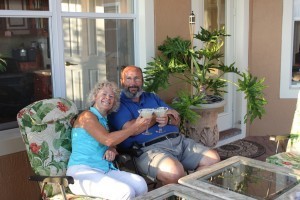 But there is a problem with Bon Voyage parties. It presents you with a kind of a deadline. It means from that point forward, everyone starts asking you, "So, when are you going to take off?"
But there is a problem with Bon Voyage parties. It presents you with a kind of a deadline. It means from that point forward, everyone starts asking you, "So, when are you going to take off?"
And much as you want to go, you look at your boat and your mind starts ticking its way through THE LIST. . . Replace engine start battery, check rigging, replace halyards, replace running light bulbs with LEDs, install new wind generator blades, sew new bimini and dodger, haul out for bottom job, replace anchor chain, and on and on. And the thing of it is that in doing any one of those jobs on THE LIST, you are just as likely to break something else while installing the something new, so it likely will take you at least two to three times as long as you think it will. When will I take off? I have no clue.
I remember one time years ago after Jim and I had spent three years building this 55-foot sailboat and we'd been living aboard and fitting her out in Ventura Marina in California. All our friends wanted to throw us a big going away party for the day we left the dock. They finally pinned us down to a date and that day at noon as the champagne corks popped, a dense fog bank sat right off the breakwater. We waved our good-byes, motored off into the fog, went about seven miles down the coast and sneeked into Channel Islands Harbor to quietly wait for a better day.
Eventually, somehow, some way, you reach a point — and it is most definitely not the bottom of the list because any sailor will tell you that you NEVER get there — but you do reach a point when you say to yourself, this is it. It's time. I've got to take off.
Last Sunday morning as I sat at my computer looking at this vast collection of files I have under the loose heading Novel Notes, I realized that my book has A LIST even longer than the boat's. Throughout the four plus years of writing this book, I have accumulated this collection of notes and questions and reminders of things I wanted to change someday, and though I've been working on this collection for months now, I don't seem to get any nearer to the bottom of THE LIST.
Then again, maybe what I really need is to plan myself a little party, to go ahead and set a date and stick to that deadline. There comes a time, even with a book, when you have to realize you'll never get to the bottom of THE LIST, it will never be perfect, and you just have to allow it to take off — and sink or swim on its own.
Fair winds!
Christine
Share on Facebook
The value of readers…
by C.E. Grundler
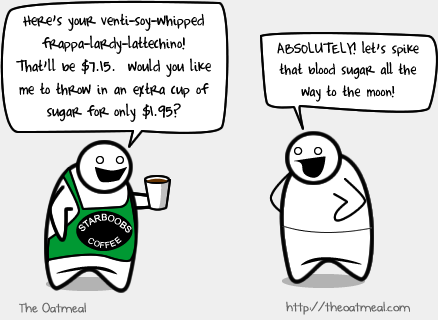
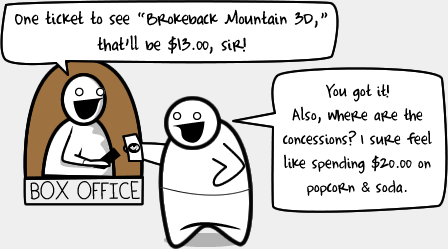
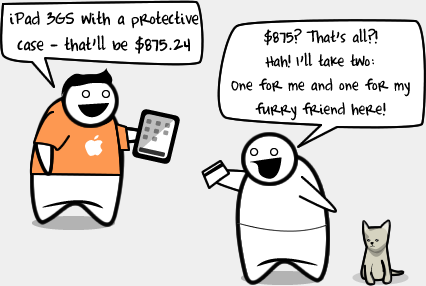
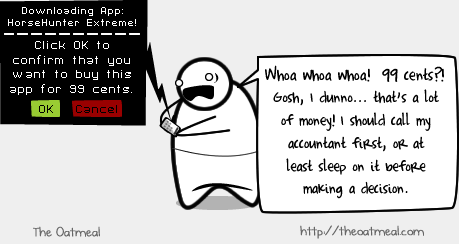
There's been much discussion this week on the whole $.99 pricing decision, and I feel I should share my experiences. April is a hectic time for me under the best of circumstances, but this year in addition to the launch into another round of 'extreme boat makeover' I'd been moving ahead on a print copy of Last Exit In New Jersey, and events occurred that made that a top priority. As usual, marketing my writing fell to the wayside, and at $2.99 my sales were less than stellar. But before I go any further, let me back up a bit.
Late last summer I entered into the ebook arena with no online presence other than a blog read by a few friends and occasional strangers seeking cures for leaky decks and the like. I priced my book at $2.99. Sales trickled in. I received some glowing reviews from readers and review bloggers, and the trickle increased somewhat. I'll be completely honest: from the start my approach to marketing has been somewhat hit-and-miss. But a while back I noticed a few new and unknown writers had set their prices $.99, and they quickly shot up in rank. I toyed around with $.99 for a short while, but various sources told me I was 'undervaluing' my work, that my writing could carry the higher price, and that discounting would hurt me in the long run. Readers, I was told, would assume the author of a bargain-priced book lacked confidence in their work, so after a few weeks of increased sales I back I went to $2.99… and my sales dropped like a rock.
Through the winter my husband had a run-in with pneumonia, I was faced with pressures from my former job, and without any marketing my sales were dismal. This March I sat down and took a closer look at the $.99 crowd, and I realized even at their discounted prices they were reaching countless more readers… and ultimately earning greater royalties. Clearly a greater number of readers weren't judging books based upon their price – they were simply looking to be entertained. So I decided to give $.99 another try, and this time I would stick with it.
I'm happy to report that it didn't take long to see results. In fact, literally overnight my sales increased to more than ten times what they'd been. Ten to one. The math is easy. Ten times more exposure to new readers, ten times more potential fans, ten times more chances for word of mouth to spread. That easily makes up the difference in per-book royalties and then some. But that was just the start. As the weeks passed, sales began to snowball. With each passing day Last Exit ranked higher in the 'Customers Who Bought This Item Also Bought' list, which in turn fuels more sales. At this point I'm selling more books per day than I'd sold in a month. Numbers that took me six months to achieve now come in weeks. It's thrilling to watch the sales rise, knowing there are so many more people out there reading my work. In making my book more affordable to readers I've made it easier for them to take a chance on a new and unknown writer. I've gained a larger audience and, in the end, higher overall earnings. Might some of those readers still bought my book at the higher price? Perhaps. But it's just as likely many others might not. They'd be missing out on a great book and I'd be missing out on a potential new fan.
Share on Facebook
April 26, 2011
E-book pricing
Earlier this week, Mike posted a blog on the merits of selling an e-book at a $.99 price point. In essence, he argued that the downside of the low royalty outlined was offset by the benefit of expanding his fan base.
An article in last Friday's Wall Street Journal highlighted just how much one writer has been able to find a new fan base when pricing a book under a buck. The WSJ captured the pricing decision of John Locke, a 58 year old self-published thriller writer started selling e-books in March of last year, as follows:
"When I saw that highly successful authors were charging $9.99 for an e-book, I thought that if I can make a profit at 99 cents, I no longer have to prove I'm as good as them," says Mr. Locke. "Rather, they have to prove they are ten times better than me."
Things turned out pretty well for Mr. Locke. According to the article, he sold 1,300 e-books last November; his January sales sky-rocketed to 75,000 units. In March he sold an amazing 369,000 e-books earning him $126,000 for the month. That's right, $126K for one month.
The question of how this happened and how many authors can replicate these results is an interesting one. However, I'd like to give some attention, not to the sales and revenue, but to the $.99 price point.
Chris Anderson, the Editor in Chief of Wired magazine writes and speaks to what he calls "The Future of Free." His contention is that digital delivery of content drives prices down to zero, be it music, video games, or books.
Anderson points to examples of this in today's market, one being Google's practice of giving away access to its search engine, the business side of the bargain being that the company makes money on advertising.
Anderson states that support for drastically low, even free, e-book pricing comes from economic theory. Namely, in a highly competitive market, price falls to marginal cost – marginal cost being the cost of producing an additional unit. In the case of e-books, marginal cost is pretty damn close to zero; the argument is that e-book pricing will be, as well.
So you (and I) might ask: are you telling me that just when this e-book thing is starting to get good, the economics are heading us toward a zero-revenue business model?
Maybe, maybe not. I'm no economist (and my undergrad advisor would be ready to attest to this fact), but I know that many authors possess pricing power. If you want to read JK Rowling you are left with only one option, JK Rowling, regardless of the marginal cost of her e-book.
So what's the conclusion here? My own take away is that e-books are rocking the publishing world in a way that gives independent writers new opportunities, yet this new emerging world of distribution likely holds future surprises for all of us, e-book authors, included.
And in the meantime? Next week I will be putting Urban Shorts, a collection of four short stories, up on Amazon. The price? I think I'll give $.99 a try.
Share on Facebook
On the road . . .
Michael Haskins
I signed "Free Range Institution" on Saturday at the famous Houston mystery bookstore, Murder by the Book. If you check out mystery bookstore websites, you should Google this store. It feels like someone's living room with shelves and shelves of books, but that doesn't take away from the feel. It is what a bookstore should look and feel like, as far as I am concerned.
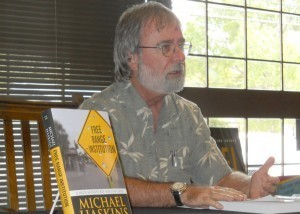
As you can imagine, I didn't draw a Texas crowd. Six people, and one of them was the daughter of a couple sailing the Caribbean that I am good friends with. But everyone
counts!
There were four pre-sales, by Internet or phone, and six sales to those that sat through my
half-hour talk. I read somewhere that the average sale at a signing is ten books. The purpose of the book singing is to meet readers and let them meet you. Supposedly, those at the signing will talk up (or down) how the signing went, how the author was, friendly, talkative or whatever, and that will drive people to buy your book (or not).
Dennis Lehane was a speaker at SleuthFest this year and he told of a signing where only three people showed up. Of course, he was disappointed, but later, thinking about it,
he realized he should have put as much into that signing as if it was a packed house. Three people gave their time to him.
I looked out at the mostly empty seats and thought of Dennis' statement. I hope I presented my story of the book, the back-story to the cover design and the reading of the
opening two pages as if I was at the Grand Ole Opry and the place was packed. People stayed afterward and we talked more personally.
I began at 4:20 pm and left the store about 4:45. The last fifteen minutes was signing stock. If I am lucky, the store will keep four or five copies and the rest will be sent
back. If you are looking for a signed copy, contact the store via its website, they have a few sitting around collecting dust.
Off to the Los Angeles Times Book Festival this coming weekend and three more book signings in the LA area. If you live on the West Coast and want to know where I'll be, go
to http://www.michaelhaskins.net/ and check out the events page.
And, if you are somewhere between Houston and Los Angeles, please drive carefully, the life you save maybe mine. (I stole that from a James Dean promo he did just before he
died in a car crash).
Will write about the book festival and signings in two weeks.
Share on Facebook

